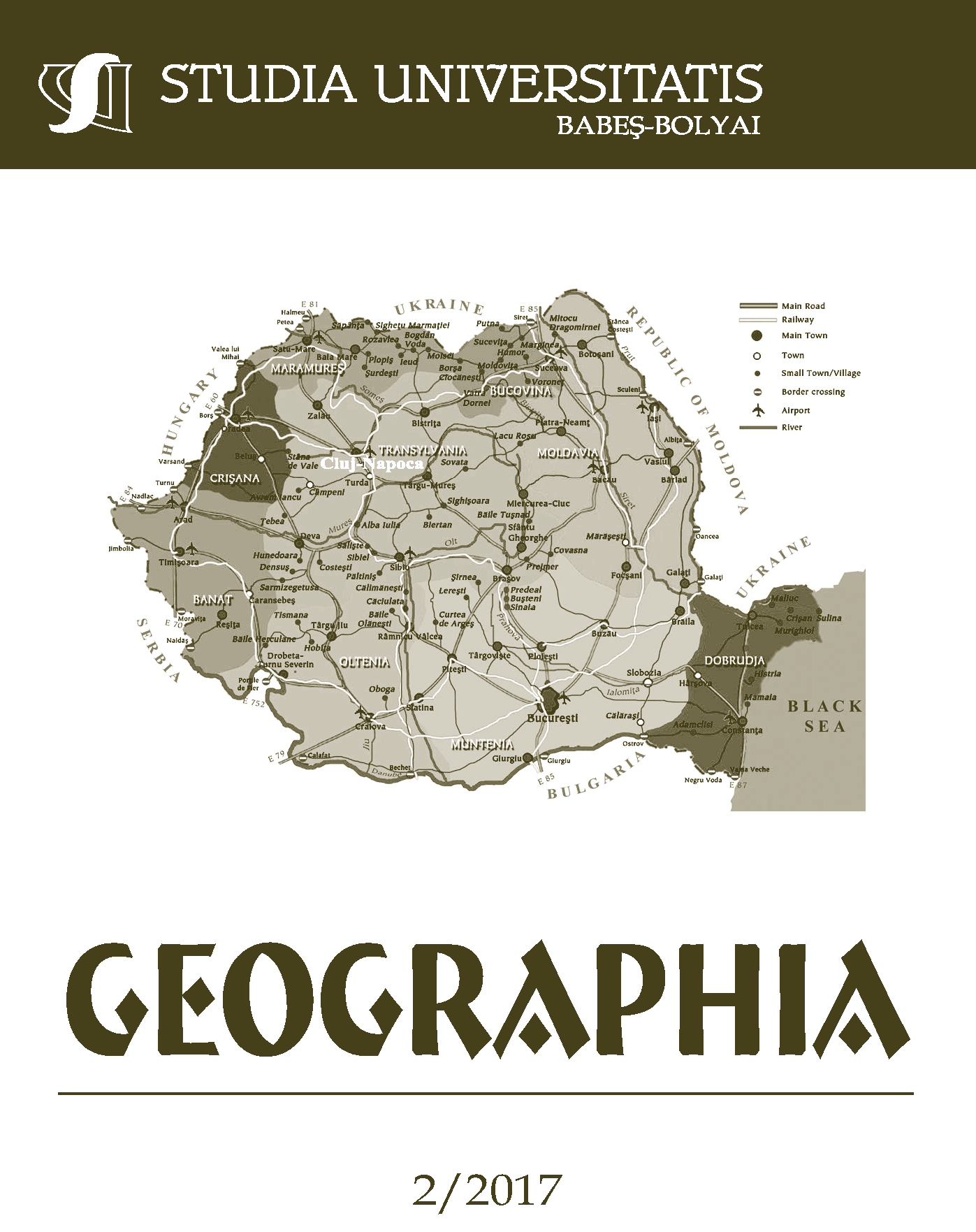CRIONIVAL PROCESSES AND THEIR EFFECT ON THE TYPES OF AGRICULTURAL LAND USE IN SILVANIA MOUNTAINS
DOI:
https://doi.org/10.24193/subbgeogr.2017.2.01Keywords:
Alpine collisional chain, Little Ice Age LIA, crionival processes, avalanches, Silvania Mountains.Abstract
Silvania Mountains are a particular geospatial entity within the geomorphological landscape of Silvania, bringing together Plopiș Mountains (Măgura Mare Peak 917 m) and Meseș Mountains (Măgura Pria Peak 996 m) and only comparatively Măgura Şimleului (597m) and Măgura Chilioarei (420 m), taking into account their high degree of erosion, into one family of mountains, forming a boundary of the vast Neogene Șimleu gulf from West to East and North-East. Between the 15th and 19th centuries, the so-called Little Ice Age (LIA) was documented for the Northern Hemisphere and in particular for the Silvania Mountains and the surrounding areas (Bihor Mountains) through the identification of fossils belonging to some buffalos, which died during the LIA. The effects of crionival processes on the types of agricultural land use in Silvania Mountains are manifested through freeze-thaw phenomena and small avalanches in close interrelationship with the climate factor and conditions offered by the adjacent Silvania sublayer.References
Alley RB, Marotzke J, Nordhaus WD et al. (2003), Abrupt climate change. Science 299: 2005–2010.
Bindoff NL, Stott PA, Achuta KM et al. (2013), Detection and attribution of climate change: From global to regional. In: Stocker TF, Qin D, Plattner G-K et al. (eds) Climate Change 2013: The Physical Science Basis. Contribution of Working Group I to the Fifth Assessment Report of the Intergovernmental Panel on Climate Change. Cambridge and New York: Cambridge University Press, pp. 867–952.
Bond G, Showers W, Cheseby M et al. (1997), A pervasive millennial-scale cycle in North Atlantic Holocene and glacial climates. Science 278: 1257–1266.
Broecker WS (2003), Does the trigger for abrupt climate change reside in the ocean or in the atmosphere? Science 300: 1519–1522.
Broecker WS and Denton GH (1989), The role of ocean–atmosphere reorganization in glacial cycles. Geochimica et Cosmochimica Acta 53: 2465–2501.
Castiglioni, G.B. (1979), Geomorfologia, Ed. UTET, Torino.
Clark PU, Marshall SJ, Clarke GKC et al. (2001), Freshwater forcing of abrupt climate change during the last glaciation. Science 293: 283–287.
Clark PU, Pisias NG, Stocker TF et al. (2002), The role of the thermohaline circulation in abrupt climate change. Nature 415: 863–869.
Dansgaard W, White JWC and Johnsen SJ (1989), The abrupt termination of the Younger Dryas climate event. Nature 339: 532–534.
Fairbanks RG (1989), A 17,000-year glacio-eustatic sea level record: Influence of glacial melting rates on the Younger Dryas event and deep-ocean circulation. Nature 342: 637–642.
Feurdean, A., Galka, M., Kuske, E., Tantau, I., Lamentowicz, M., Mulch, A., Hickșer, T. (2015), Last Millenium hydro-climate variability in Central-Eastern Europe (Northen Carpathians,Romania), The Holocene, Vol. 25(7) II79-II92,Sage.
Hughen KA, Overpeck JT, Lehman SC et al. (1998), Deglacial changes in ocean circulation from an extended radiocarbon calibration. Nature 391: 65–68.
Josan, I., 2009, Ţara Silvaniei, studiu de geografie regională, p. 7-96, 195-228. Editura Universităţii din Oradea.
Keigwin L.D, Jones GA, Lehman SJ et al. (1991), Deglacial meltwater discharge, North-Atlantic deep circulation, and abrupt climate change. Journal of Geophysical Research 96(C9): 16811–16826.
Lehman SJ, Jones GA, Keigwin LD et al. (1991) Direct evidence for early retreat of the Fennoscandian ice sheet during the last deglaciation. Nature 349: 513–516.
Muscheler R, Beer J, Wagner G et al. (2000), Changes in deepwater formation during the Younger Dryas event inferred from Be-10 and C-14 records. Nature 408: 567–570.
Paasche Ø, Løvlie R, Dahl SO et al. (2004), Bacterial magnetite in lake sediments: Late glacial to Holocene climate and sedimentary changes in northern Norway. Earth and Planetary Science Letters 223: 319–333.
Severinghaus J.P. and Brook EJ (1999), Abrupt climate change at the end of the last glacial period inferred from trapped air in polar ice. Science 286: 930–934.
Trenberth K, Overpeck J and Solomon S (2004), Exploring drought and its implications for the future. EOS 85: 27.
Trenberth KE (1997), Short-term climate variations: Recent accomplishments and issues for future progress. Bulletin of the American Meteorological Society 78: 1081–1096.
Veron, A., Novak, M., Brizova, E., Stepanova, M. (2014), Environmental imprints of climate changes and anthropogenic activities in the Ore Mountains of Boemia (Central Europa) since 13 cal.kyr BP, The Holocene,Vol.24(8) 919-931,Sage.
Voica, Bojar. A., Guja, O., Pelc. A, Piotrowska, Vasile, S. (2015), Bison bonasus skull from the Bihor Mountains, Romania: Isotopic and morphological investigations, The Holocene,Vol.25(7) II34-II43,Sage.
Wunsch, C. (2006), Abrupt climate change: An alternative view. Quaternary Research 65: 191–203.
Downloads
Published
How to Cite
Issue
Section
License
Copyright (c) 2017 Studia Universitatis Babeș-Bolyai Geographia

This work is licensed under a Creative Commons Attribution-NonCommercial-NoDerivatives 4.0 International License.





 ©Studia Universitatis Babeş-Bolyai Geographia. Published by Babeș-Bolyai University.
©Studia Universitatis Babeş-Bolyai Geographia. Published by Babeș-Bolyai University.